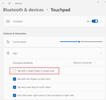Recent posts:
Edifier MR4 Powered Studio Monitor Speakers

Changing the Windows touchpad settings programmatically

Customising and optimising Windows 11 installation

ConfigureFunctionsWorkerDefaults vs ConfigureFunctionsWebApplication in .NET Azure Functions

DDD Melbourne 2025
